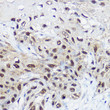| Tissue Specificity | Isoform 1: Mainly expressed in non-neuronal tissues such as lung, breast, kidney, and ovary. Isoform 2: Expressed in lung, breast, kidney, ovary, skeletal muscle and brain. |
| Function | Isoform 1: Catalytically inactive when either DNA or nucleosomes are the substrate and does not possess chromatin-remodeling activity. Acts as a negative regulator of chromatin remodelers by generating inactive complexes. Isoform 2: Helicase that possesses intrinsic ATP-dependent chromatin-remodeling activity. ATPase activity is substrate-dependent, and is increased when nucleosomes are the substrate, but is also catalytically active when DNA alone is the substrate. Catalytic subunit of ISWI chromatin-remodeling complexes, which form ordered nucleosome arrays on chromatin and facilitate access to DNA during DNA-templated processes such as DNA replication, transcription, and repair. Within the ISWI chromatin-remodeling complexes, slides edge- and center-positioned histone octamers away from their original location on the DNA template. Catalytic activity and histone octamer sliding propensity is regulated and determined by components of the ISWI chromatin-remodeling complexes. The BAZ1A-, BAZ1B-, BAZ2A- and BAZ2B-containing ISWI chromatin-remodeling complexes regulate the spacing of nucleosomes along the chromatin and have the ability to slide mononucleosomes to the center of a DNA template. The CECR2- and RSF1-containing ISWI chromatin-remodeling complexes do not have the ability to slide mononucleosomes to the center of a DNA template. Within the NURF-1 and CERF-1 ISWI chromatin remodeling complexes, nucleosomes are the preferred substrate for its ATPase activity. Within the NURF-1 ISWI chromatin-remodeling complex, binds to the promoters of En1 and En2 to positively regulate their expression and promote brain development. May promote neurite outgrowth. May be involved in the development of luteal cells. |
| Protein Name | Probable Global Transcription Activator Snf2l1Atp-Dependent Helicase Smarca1Nucleosome-Remodeling Factor Subunit Snf2lSwi/Snf-Related Matrix-Associated Actin-Dependent Regulator Of Chromatin Subfamily A Member 1 |
| Cellular Localisation | Nucleus |
| Alternative Antibody Names | Anti-Probable Global Transcription Activator Snf2l1 antibodyAnti-Atp-Dependent Helicase Smarca1 antibodyAnti-Nucleosome-Remodeling Factor Subunit Snf2l antibodyAnti-Swi/Snf-Related Matrix-Associated Actin-Dependent Regulator Of Chromatin Subfamily A Member 1 antibodyAnti-SMARCA1 antibodyAnti-SNF2L antibodyAnti-SNF2L1 antibody |
Information sourced from Uniprot.org







